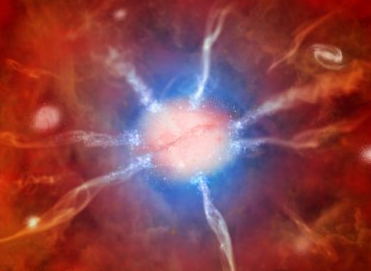We're open daily! View holiday hours
Science News
Phoenix Cluster
August 17, 2012
by Alyssa Keimach

About 5.7 billion light years from Earth lies a strange galaxy cluster that’s setting the record for both size and pace of star formation.
The South Pole Telescope discovered a large group of galaxies orbiting one another, bound together by gravity. Observations with the Gemini Telescope determined the distance to the galaxy cluster and revealed a behemoth galaxy at its center. But it took the Chandra X-Ray Observatory to discover the significance of the Phoenix Cluster when the observatory detected its x-ray emission—the strongest ever known!
From the Chandra data, astronomers understand that Phoenix contains a vast reservoir of hot gas, just like other galaxy clusters. But in this case, the x-ray emission appears to come from cooling gas in the center of the cluster. If the gas in the center is cooling rapidly, this means that stars are forming there at a breakneck pace.
The galaxy cluster produces more than 700 new stars per year, while regular galaxies produce one new star every few years. As a result, this cluster houses three trillion stars, compared to the 200 billion stars in the Milky Way.
So how does the Phoenix Cluster stay cool? There must be less energy at its center. The supermassive black hole that presumably exists in the core of the central galaxy must not emit the hot jets that counteract the cooling process. Most galaxy clusters have their star formation shut down when jets emanating from material around supermassive black holes heat up the surrounding cluster gas.
Despite (and because of) its record-breaking status, Phoenix probably can’t keep up the pace, researchers say. “The galaxy and its black hole are undergoing unsustainable growth,” says Bradford Benson, of the University of Chicago. “This growth spurt can't last longer than about a hundred million years. Otherwise, the galaxy and black hole would become much bigger than their counterparts in the nearby universe.”
Benson and his colleagues reported their findings in this week’s Nature.
Illustration: NASA/CXC/M.Weiss
Alyssa Keimach is an astronomy and astrophysics student at the University of Michigan and volunteers for the Morrison Planetarium.